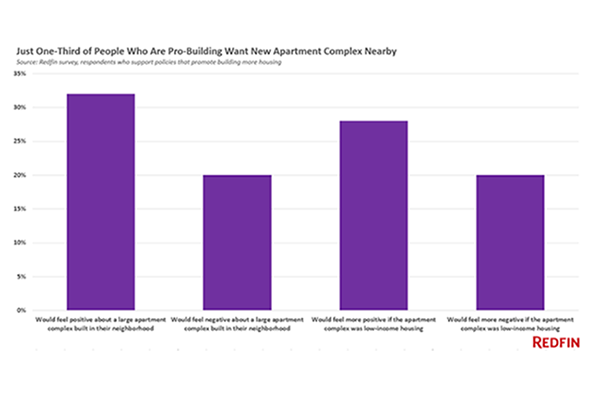
Redfin: Most Respondents Support More Housing, But Many Don’t Want Apartments in Their Neighborhood

(Chart courtesy of Redfin)
A recent Redfin survey finds that nearly 80% of respondents support policies that promote building more housing.
Although the report finds that the majority of respondents are pro-building, just one-third (32%) of respondents would feel positive about an apartment community being built in their neighborhood, while 20% would feel negative and nearly half (48%) would feel neutral.
When broken down by homeowners versus renters, 74% of owners support policies that promote building more housing, compared with 80% of renters. One-quarter of owners would feel positive about a new apartment community being built in their neighborhood, which is just about on par with 28% of renters. Two in five owners would feel negative about a new apartment community being built in their neighborhood, and a smaller percentage (35%) of owners would feel neutral. That’s compared with about one-quarter (24%) of renters feeling negative about the prospect of a new apartment community nearby, and nearly half (49%) who would feel neutral.
The U.S. had an estimated housing shortfall of 3.8 million units as of 2021, and both buying and renting a home is more expensive in 2023 than it’s ever been. Prices continue to rise due to elevated mortgage rates and a shortage of homes for sale. Building more housing would narrow the gap between supply and demand and help make housing more affordable. Policies that promote building include loosening zoning restrictions, allowing accessory dwelling units (ADUs) and enacting tax incentives that would encourage developers to build.
“Personal preferences for things like a quiet neighborhood or old-fashioned charm are often at odds with building new housing,” said Redfin Chief Economist Daryl Fairweather. “Even though so many Americans believe in building new dense housing in theory, that ideology isn’t strong enough to outweigh their own desires–especially when they don’t stand to directly benefit from the building. That’s why it’s so difficult to overcome community opposition to dense new housing, even during a time when so many Americans believe in the Yes In My Backyard (YIMBY) movement.”
Most Democrats and Republicans are pro-building – but not necessarily in their neighborhood
The majority of both Democrats and Republicans support policies that promote building more housing. But a minority of both parties would feel positive about a new apartment community being built in their neighborhood.
More than eight in 10 (83%) respondents identifying as Democrats are pro-building, compared to three-quarters (75%) of respondents who identify as Republicans.
About one-third (34%) of Democrats would feel positive about a large new apartment community to be built in their neighborhood, compared with 24% of Republicans. Just under one-quarter (23%) of Democrats would feel negative about a large community being built in their neighborhood, versus 37% of Republicans. Roughly two in five Democrats (43%) and Republicans (40%) would feel neutral.
While Republicans are more likely than Democrats to be opposed to a large new community in their neighborhood, the South – comprised primarily of Republican leaning states – is building far more homes than any other parts of the country. Southern states issued 576,000 single-family building permits in August, which is more than double the number of permits for any other region, and up 10% year over year. This is compared to 4% increases in the Midwest and West, and a 5% decrease in the Northeast.
“There are YIMBYs and NIMBYs on both sides of the aisle,” Fairweather said. “That’s part of the reason it’s so difficult to push through policies that promote dense housing. But all types of building ultimately help with housing supply and affordability, even building more single-family homes. The more homes that exist, the more likely it is a person can find one to fit their needs and their budget. So even though Republicans are more likely to oppose dense housing, the South is doing more than other regions to create more housing and help with affordability. Looking forward, governments in some red and blue states are prioritizing affordable housing. In Montana, for instance, a wave of bipartisan legislation to reform zoning is making its way through the government, and California lawmakers have eliminated barriers to building ADUs.”
Democrats are almost twice as likely as Republicans (34% and 19% respectively) to feel more positively if the apartment community built in their neighborhood was for low-income residents. About half of both groups would feel neutral.
